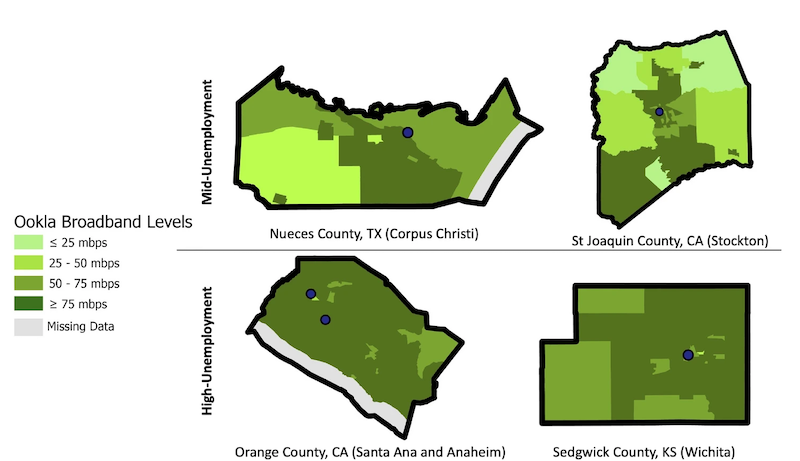Infrastructure as a social sensor
A recent study examines the relationship between having access to broadband internet and unemployment during the pandemic.
During the COVID-19 pandemic, inequalities across social groups were magnified in many ways, and perhaps most dramatically through employment and access to education services. Internet connectivity played a crucial role, as connectivity became paramount with schools and workplaces transitioning to virtual formats.

Nikki Ritsch
A recent study published in Nature Scientific Reports led by Nikki Ritsch and co-authored with advisor Daniel Armanios, examined the relationship between having access to broadband internet and unemployment during the pandemic. Coining a new concept, “infrastructure as a social sensor,” the research looked at broadband access at the county level across the United States.
“Previous research has already identified the existence of gaps in the infrastructure,” says Ritsch, an engineering and public policy doctoral student. “Our work seeks to further understand these gaps and how we can use them to proactively address future investments.”
Ritsch’s infrastructure as a social sensor approach focuses on treating infrastructure as a proxy for bias rather than access, as has been historically assumed in past research. By using this framing, they find that they can build a model to detect vulnerable communities that live in the gaps of broadband internet networks. Ritsch explains that this is where the term “infrastructure as social sensor" comes from. In the paper, they explore where this kind of method is useful and find it is effective in identifying communities who are critically dependent on broadband-based work or groups that have been historically marginalized in their broadband access.
By treating infrastructure as a social sensor of bias and inequities, this work intends to improve how social vulnerabilities are addressed
Nikki Ritsch, Doctoral candidate, Engineering and Public Policy
This study also considered the levels of essential workers, who would likely not need access to broadband at home in comparison to those who would be able to do their jobs remotely. Lower levels of essential workers indeed sharpened the sensor and reflected a larger gap in unemployment. Counties with higher percentages of Hispanic and Black populations were also found to be more adversely affected due to their systematically lower broadband access.
“By treating infrastructure as a social sensor of bias and inequities, this work intends to improve how social vulnerabilities are addressed, particularly in times of crisis, by providing services in a more efficient and timely manner,” notes Ritsch.

Source: Nature Scientific Reports
A highlight of treated counties, which showcase how access is more clustered for treated counties with higher average unemployment. We see that in Orange and Sedgwick counties, the lack of broadband access is heavily clustered whereas in Nueces and St Joaquin County, the broadband access is more distributed.
Additionally, the study also emphasizes the value of combining multiple infrastructure systems to form an “array” of sensors to further sharpen the factors that can best identify and reduce inequities. By adding infrastructure as a social sensor to existing methods of measuring bias, support systems, for example in this case libraries that can offer free broadband, can better target assistance to the most vulnerable populations during times of crises.
